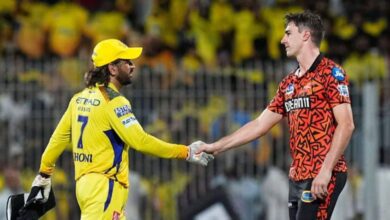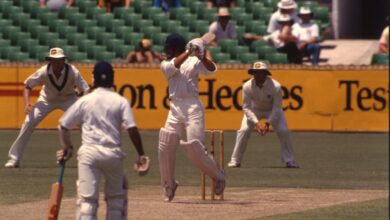2024 in review — Big Two dominance in 2024 marks start of a new dawn
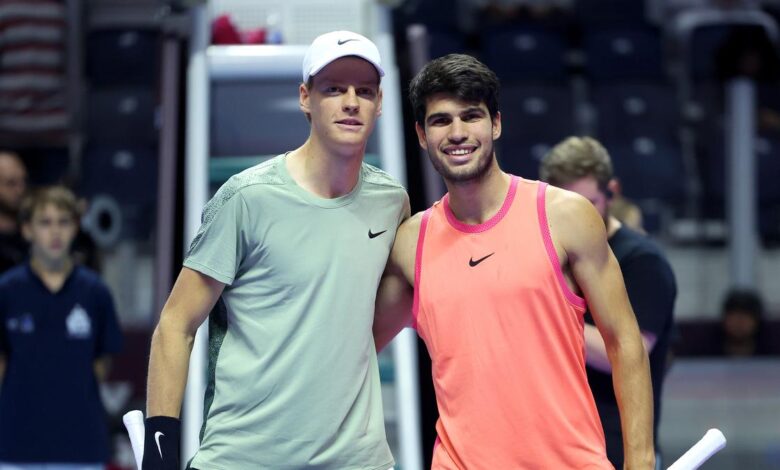
For the first time since 2002, none of the iconic Big Three — Novak Djokovic, Rafael Nadal, and Roger Federer — captured a Grand Slam singles title. This triumvirate, by far the most accomplished players in men’s tennis history, amassed 66 Major titles, with Djokovic at 24 and the retired champions Nadal and Federer finishing with 22 and 20, respectively. The age-defying Serb proved he’s not washed up at 37 by securing gold at the Paris Olympics.
The new Big Two — Jannik Sinner and Carlos Alcaraz — confirmed Federer’s maxim, much like Steffi Graf and Monica Seles did 35 years ago when they dethroned legendary queens Martina Navratilova and Chris Evert.
Contrasting personalities and styles have already ignited the Alcaraz-Sinner rivalry. Fire vs Ice. Bold Creativity vs Relentless Power. Sinner finished the year ranked No. 1, but Alcaraz defeated him in all three encounters, most notably in semifinal thrillers at the French Open and Indian Wells.
For devotees of Federer and Nadal pining for their bygone heroes, the colourful Carlos said, “I’m a little bit of Roger, a little bit of Rafa, and a little bit of me.” Meanwhile, the low-key Jannik plays much like a harder-hitting version of Novak, employing similar technique and tactics but with a much different demeanor.
In 2024, the Big Two dominated the Grand Slam events as greedily as the Big Three once did. Sinner triumphed in the hard-court Majors at the Australian and US Opens, while Alcaraz prevailed on the French Open clay and Wimbledon grass.
Sinner needed every ounce of his preternatural equanimity during his breakthrough season. In the Australian Open final, Daniil Medvedev came within six points of the title, with Sinner serving at 4-all, 40-all in the third set. But the Russian choked, making two unforced forehand errors, and the momentum abruptly shifted. Serving for the championship at 5-3, 30-all in the deciding set, the 22-year-old Italian calmly unleashed two point-winning forehands to secure a 3-6, 3-6, 6-4, 6-4, 6-3 victory and his first Grand Slam title.
If Sinner’s passionate fans were nervous wrecks during these crises, their hero wasn’t. “I like to dance in the pressure storm,” he said afterwards. “I like it because that’s where most of the time I bring out my best tennis.”
Sinner managed to play his best tennis most of the time despite enduring a doping controversy. In March, he tested positive twice for Clostebol (a testosterone-like anabolic steroid) after his physiotherapist treated his open wounds at Indian Wells with an over-the-counter spray containing a minute amount of the prohibited substance. On August 20, the International Tennis Integrity Agency (ITIA) confirmed that an independent tribunal convened by Sport Resolutions ruled that Sinner bore No Fault or Negligence for two Anti-Doping Rule Violations under the Tennis Anti-Doping Programme (TADP). The World Anti-Doping Agency (WADA) appealed the verdict to the Court of Arbitration for Sport (CAS), which will decide whether Sinner will be suspended from competition for up to two years.
Sinner won eight tournaments, led Italy to its second consecutive Davis Cup title, and racked up an amazing 73-6 match record.
| Photo Credit:
Getty Images
Sinner won eight tournaments, led Italy to its second consecutive Davis Cup title, and racked up an amazing 73-6 match record.
| Photo Credit:
Getty Images
Sinner won eight tournaments, led Italy to its second consecutive Davis Cup title, and racked up an amazing 73-6 match record, but the stress took its toll. In November, he confided, “I’ve kept thinking about where we went wrong and what we could have done better. I had days where I wasn’t feeling great; nights when I didn’t sleep well.”
Alcaraz also had his mettle tested in an up-and-down year. At the French Open, he needed a painkiller and a massage from the trainer in the fourth set of the final against Alexander Zverev but pulled off a 6-3, 2-6, 5-7, 6-1, 6-2 triumph. At 21, the Spanish sorcerer became the youngest man to win Grand Slam titles on hard, clay, and grass courts, edging Nadal, who achieved the feat at 22 during the 2009 Australian Open. The dramatic final overshadowed an even closer, higher-quality semifinal, where Alcaraz overcame Sinner 2-6, 6-3, 3-6, 6-4, 6-3. Afterwards, Alcaraz channelled his boyhood idol Nadal when he told the crowd, “You have to find the joy in suffering. That’s the key.”
Changing of the guard
Before the Wimbledon final, ESPN analyst Patrick McEnroe correctly predicted, “The changing of the guard becomes official today.” How fitting that on the 150th anniversary of modern tennis — which began on grass in Victorian England — the sport’s undisputed GOAT faced a worthy successor in defending champion Alcaraz. As Djokovic said during the fortnight, “History is on the line.”
On June 5, Djokovic underwent surgery to repair a torn meniscus suffered at the French Open and wasn’t sure he’d participate in Wimbledon until four days before the start of the revered tournament he’d captured seven times.
Alcaraz whacked winners from every conceivable angle in the first two sets and then weathered a mini comeback in the third set by Djokovic to notch a 6-2, 6-2, 7-6(4) victory in what the Spaniard rated as “probably the best match of my career.”
ESPN analyst John McEnroe said, “The mental strength after he blew the 40-love lead [three championship points serving at 5-4] is one of the many reasons we love this guy.”
Another reason is the graciousness Alcaraz shows towards his opponents. “I’m still believing that Novak is Superman because of what he has done in this tournament with surgery just a few weeks before the tournament began. It is amazing.”
Djokovic hadn’t exactly been Superman in 2024, failing to win a tournament going into the Paris Olympics. People wondered whether he could somehow use his Wimbledon momentum to capture the only prestigious title missing from his incomparable résumé?
In a nostalgic, throwback match, Novak defeated Nadal 6-1, 6-4 in the second round and outclassed Stefanos Tsitsipas 6-3, 7-6(3) and Lorenzo Musetti 6-4, 6-2 to reach the final. Then he avenged his Wimbledon loss by edging Alcaraz 7-6(3), 7-6(2) in the greatest straight-sets men’s match in history.
“I’m just over the moon,” said the ecstatic gold medallist who achieved his lifelong dream after three unsuccessful attempts. “Honestly, everything I felt in that moment when I won really surpassed everything I thought or hoped it would be. I thought carrying the flag at the [2012 Olympic] opening ceremony was the best feeling ever until I experienced today. Being on that court with [the] Serbian flag raised and singing the Serbian anthem with the gold [medal] around my neck — nothing can beat that in professional sport.”
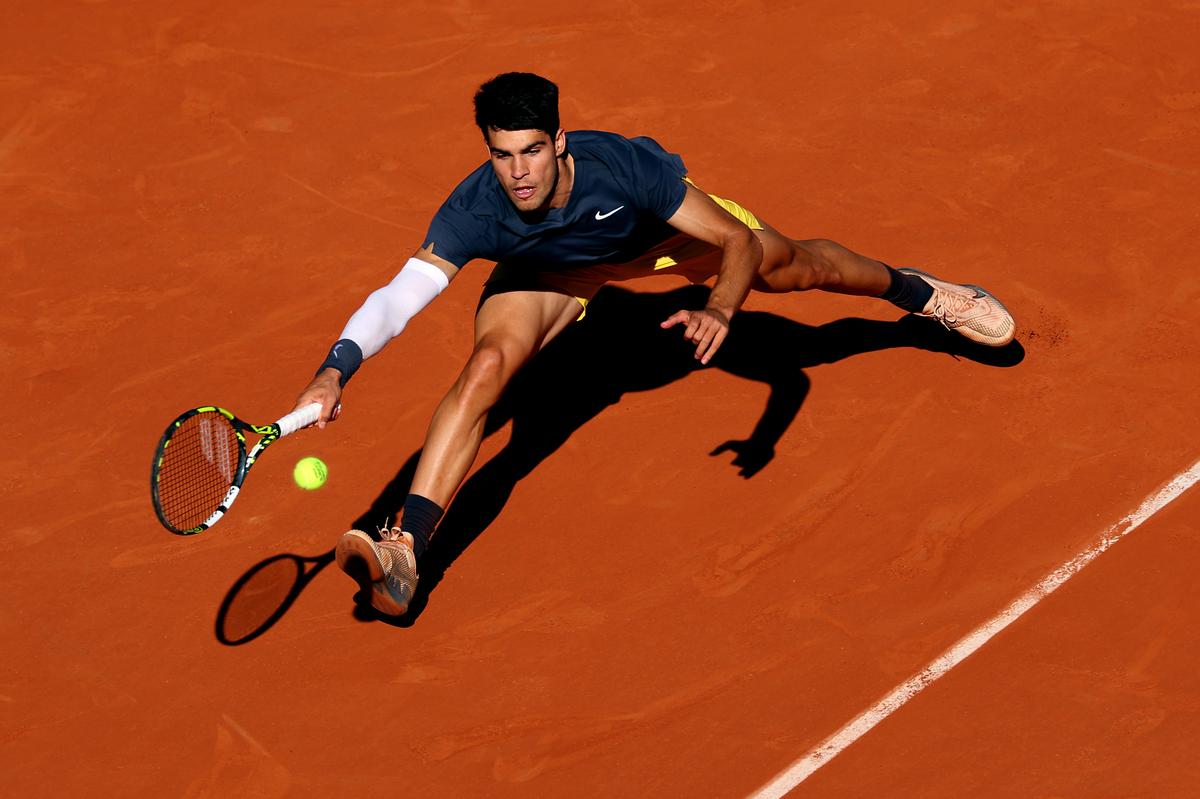
Meanwhile, Alcaraz (right) won four titles overall, including the French Open and Wimbledon, beating Sinner multiple times along the way.
| Photo Credit:
Getty Images
Meanwhile, Alcaraz (right) won four titles overall, including the French Open and Wimbledon, beating Sinner multiple times along the way.
| Photo Credit:
Getty Images
At the US Open, both Alcaraz and Djokovic faltered. Carlos succumbed 6-1, 7-5, 6-4 to 74th-ranked Botic van de Zandschulp, a Dutchman who had contemplated retiring at the end of the year due to a lack of motivation. “You talk about a shocker,” said John McEnroe. “It has to be at the top of the all-time shockers.” Meanwhile, the 28th-seeded Alexei Popyrin, a late-blooming Aussie with a big serve and potent forehand, upset a sluggish Djokovic 6-4, 6-4, 2-6, 6-4 with 50 winners to reach the fourth round at a Major for the first time. Of far greater historical significance, it marked the first time since 2002 that none of the legendary Big Three won a Major.
Instead, Sinner ensured that the remaining half of the new Big Two reigned supreme. The 23-year-old Italian eliminated a quartet of Americans, plus No. 5 Daniil Medvedev — who had beaten Sinner at Wimbledon — and fast-rising Englishman Jack Draper.
Taylor Fritz defeated No. 8 Casper Ruud 3-6, 6-4, 6-3, 6-2 and No. 4 Alexander Zverev 7-6(2), 3-6, 6-4, 7-6(3) to reach his first Grand Slam semifinal where he outlasted No. 20 Frances Tiafoe, a muscle-flexing showman, 4-6, 7-5, 4-6, 6-4, 6-1 to become the first American man since Andy Roddick in 2006 to reach the US Open final. Roddick was also the last American man to win a Grand Slam singles title, way back in 2003 at Flushing Meadows.
The good-looking, soft-spoken California Kid sounded confident he could end the 21-year drought. “I have a feeling I’m going to come out and play really well and win,” Fritz said. “When I play good tennis, I think that level is good enough to win.”
It certainly wasn’t anywhere near “good enough,” as Sinner outplayed Fritz 6-3, 6-4, 7-5 to become only the fourth man in 50 years to win his first two Majors in the same calendar year. (Jimmy Connors won three Majors in 1974!)
Patrick McEnroe sounded cautiously optimistic about current American standouts Fritz, Tiafoe, and Tommy Paul. “You’re close, but you’re still pretty far [from winning a Major]. They still have to improve a lot of little things in their games.”
McEnroe was more certain about Sinner and Alcaraz. “Are these two guys going to dominate the way the Big Three did? Yes.”
Sinner went on to win 18 of his last 19 matches, losing only to Alcaraz 6-7 (6), 6-4, 7-6 (3) in a sensational Beijing final. “Alcaraz has a gear that goes to 11 [out of 10], even against Sinner,” said former No. 1 Jim Courier.
In the season-ending ATP Finals, Sinner put an exclamation point on his tremendous year there, decisively defeating De Minaur, Medvedev, Ruud, and Fritz (twice).
“I have no doubt Sinner will be a force next year,” said Courier. “But will he play? WADA may suspend him for a year or two.”
SABALENKA DETHRONES SWIATEK IN NEW TENNIS WORLD ORDER
“Uneasy lies the head that wears a crown” – Shakespeare’s King Henry IV Part 2.
Ever since Serena Williams won her 23rd and final Grand Slam singles title eight years ago, no dominant women’s superstar has emerged in a sport that thrives on great players and riveting rivalries.
Iga Swiatek came closest with five Majors, but her reign was mainly on clay, as her four French Open victories attested. The intense Pole, limited by a one-dimensional game, has reached the semifinals just twice in the past eight Majors. Before her, Naomi Osaka appeared to be Serena’s heir apparent with a similar high-powered game. Alas, the Japanese player’s success was limited to four Major titles on hard courts. Following a hiatus during which she gave birth to a daughter in July 2023, she has yet to regain her championship form. Australian Ash Barty, the best pure athlete since Justine Henin, captured a Major on each surface, only to retire abruptly after winning her home Slam three years ago.
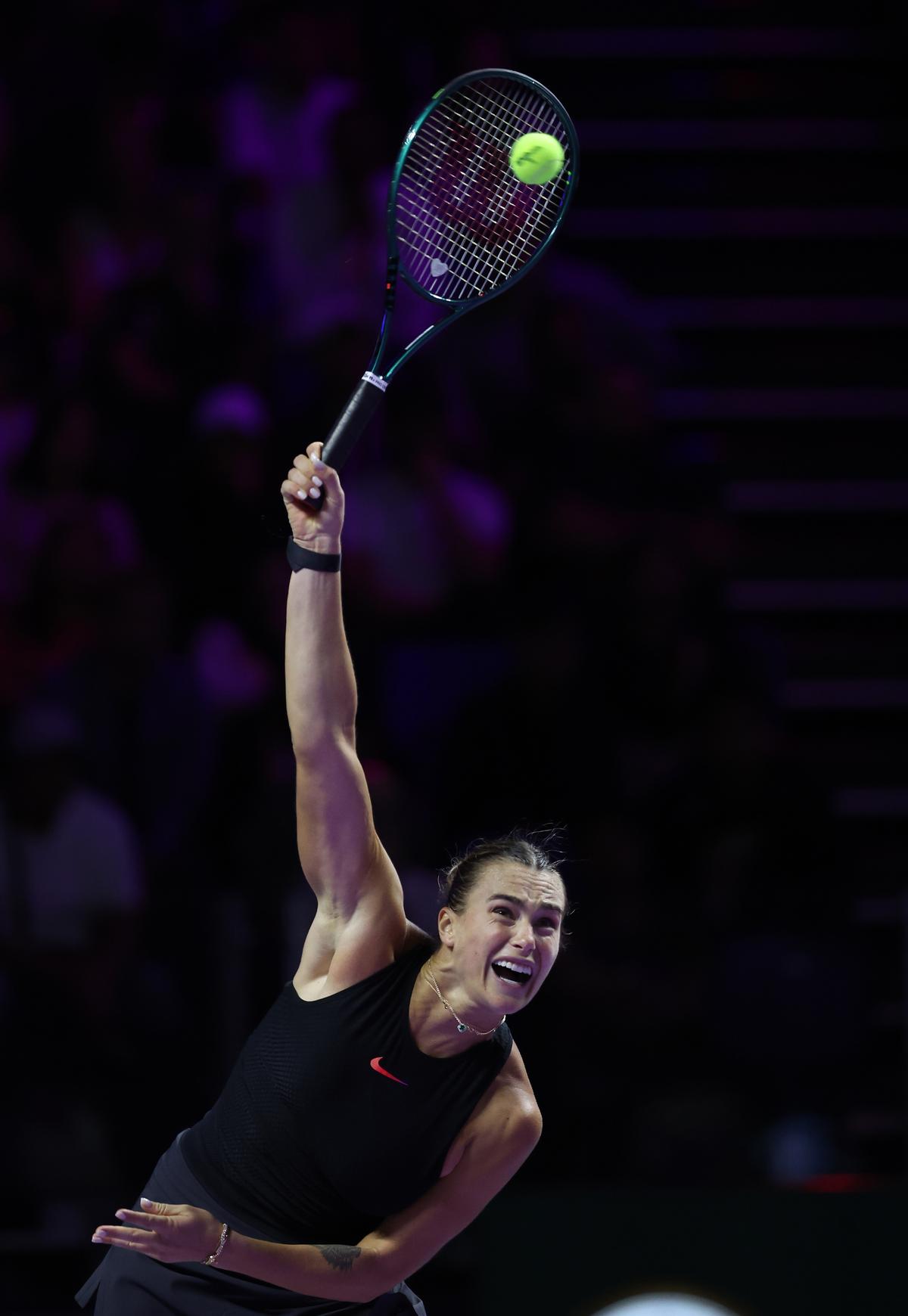
In 2024, Aryna Sabalenka looked like the superstar we’d been waiting for in women’s tennis since Serena Williams.
| Photo Credit:
Getty Images
In 2024, Aryna Sabalenka looked like the superstar we’d been waiting for in women’s tennis since Serena Williams.
| Photo Credit:
Getty Images
In 2024, Aryna Sabalenka increasingly looked like the superstar we’d been waiting for — and the one her late father Sergey, a former ice hockey player, had predicted she would become. Sabalenka recalled, “He told me then that I had everything I needed to achieve this goal: I just had to learn myself better, learn how to control my emotions, and one day I’d be world number one. It was like our dream.”
Their dream came true on September 11, 2023, though Sabalenka finished the year ranked No. 2 behind Swiatek. Indeed, the lean, 5’11”, broad-shouldered Belarusian has everything: an ideal tennis physique, superb strokes and footwork, athleticism, and newly added finesse to complement her tremendous power.
However, doubts persisted about her mental toughness even after Sabalenka overcame Elena Rybakina in the 2023 Australian Open final for her first Grand Slam title. She subsequently suffered disappointing three-set upset losses to Karolina Muchova at Roland Garros, Ons Jabeur at Wimbledon, and, most dishearteningly, Coco Gauff in the memorable US Open final.
At the 2024 Australian Open, a more relaxed and confident Sabalenka pummeled No. 9 seed Barbora Krejcikova 6-2, 6-3 in the quarterfinals and then spoke about a score to settle with rising star Gauff. “I love it. After [the 2023] US Open, I really wanted that revenge,” Sabalenka said. “It’s always great battles against Coco, with really great fights. I’m happy to play her, and I’m super excited to play that semifinal.”
Before their eagerly anticipated rematch, former No. 1 Lindsay Davenport, now a Tennis Channel analyst, voiced what many were wondering: “[At] the last three Majors, Sabalenka has really melted down. Does she have the mental game to hang in there?”
Highly animated but far less agitated this season, the new Sabalenka relentlessly attacked Gauff’s second serve, claimed the critical first-set tiebreak 7–2, and prevailed 7-6 (2), 6-4. Highlighting Sabalenka’s success in winning 14 of 17 points on Gauff’s second serve, Davenport described it as “an A-plus performance.”
Major upsets decimated the top seeds in the other half of the draw. Swiatek, who struggles against power players, was ousted by Linda Noskova, a 19-year-old Czech, 3-6, 6-3, 6-4. Russia’s unheralded Anna Blinkova outlasted No. 3 seed and 2022 Wimbledon champion Elena Rybakina 6-4, 4-6, 7-6 (20). The fluctuating tiebreak — in which Blinkova fended off six match points before prevailing on her tenth — prompted ESPN analyst Pam Shriver to remark, “You don’t see 16 match points, maybe once in a lifetime.”
The carnage opened up the draw for No. 12 Zheng Qinwen to reach the final without facing a seeded player. The tournament invited China’s Li Na, Zheng’s childhood idol, to honour her on the 10th anniversary of her historic title there, and she surprised the delighted Zheng in the clubhouse lounge. The Hall of Famer and the blossoming star hugged and chatted, with Li advising her to “keep it simple and not overthink.”
Neither that good advice nor vocal front-row Chinese spectators in red hats were enough to help Zheng dethrone Sabalenka in the final. Both finalists played “first-strike” power tennis, though Sabalenka did it much better. Opponents could no longer rely on her double faults — once her bête noire — as Sabalenka committed just 10 in her first six matches and none in the final. Summing up Sabalenka’s 6–3, 6–2 masterclass, ESPN analyst Mary Joe Fernandez commented, “There are no holes in Sabalenka’s game. This is as dominant a performance as you’ll see in a Grand Slam final.”
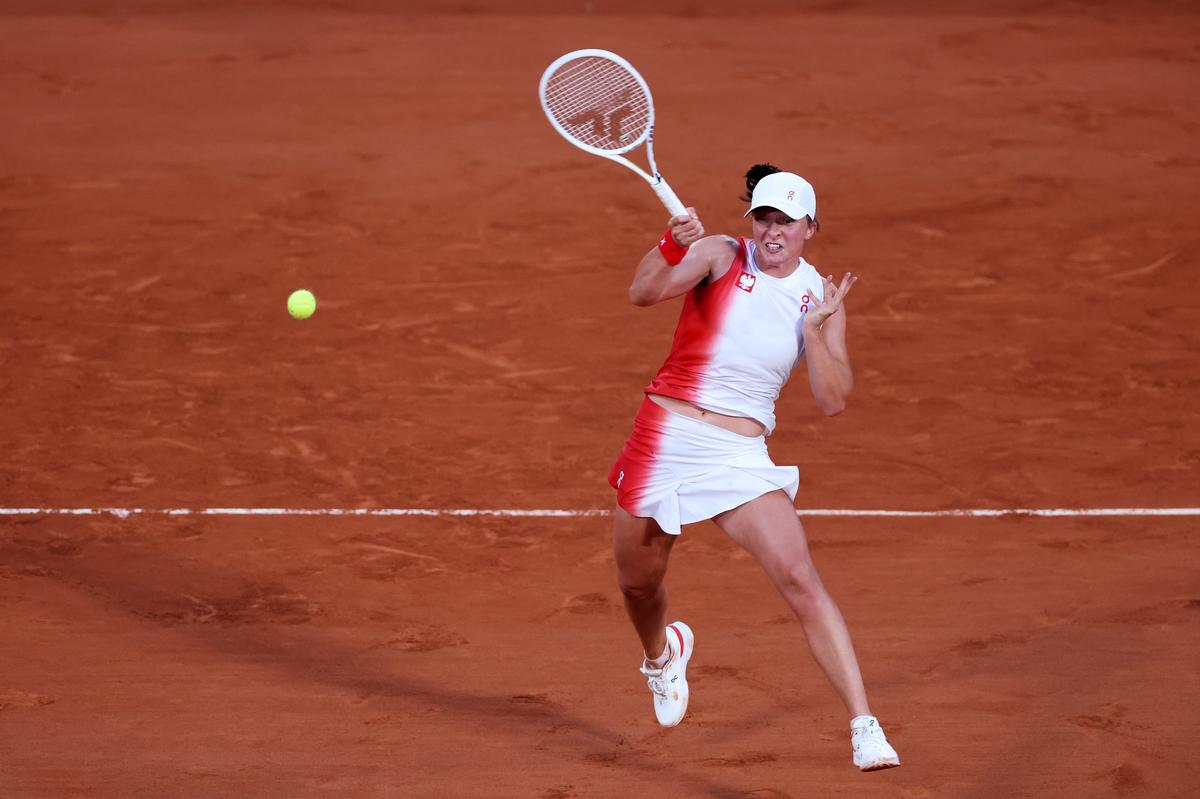
Queen of clay: By her high standards, Iga Swiatek’s season was disappointing, yet she still claimed her fourth French Open and fifth Grand Slam title, winning titles in Madrid and Rome, and securing a bronze medal at the Paris Olympics, all on her favoured surface.
| Photo Credit:
Getty Images
Queen of clay: By her high standards, Iga Swiatek’s season was disappointing, yet she still claimed her fourth French Open and fifth Grand Slam title, winning titles in Madrid and Rome, and securing a bronze medal at the Paris Olympics, all on her favoured surface.
| Photo Credit:
Getty Images
In a low-key victory celebration, Sabalenka raised her arms and blew kisses to the cheering crowd. Then she scurried to hug her team, tapping her easy-going fitness trainer Jason Stacy on his bald head. It was all good fun, as Sabalenka had slapped and autographed his bald dome before matches and even stretched her legs by kicking objects off it.
Little giant killer
At the Dubai Duty Free Tennis Championships in February, an undersized (5’4”) but bold-hitting Italian surprised almost everyone. Jasmine Paolini defeated five top-40 opponents (receiving a walkover from Rybakina) to capture the WTA 1000 event, the biggest title of her career. Her smiles, as much as her scrambling defence and exciting shot-making, made her a crowd favourite as the late bloomer (28) rebounded to claim a 4-6, 7-5, 7-5 victory over Anna Kalinskaya in an all-unseeded championship match.
Swiatek got her groove back at Indian Wells, losing just 21 games across six matches. In the final, Swiatek overpowered No. 9 Maria Sakkari, her only top-10 opponent, 6-4, 6-0. The 5’9” Polish athlete leapt for joy after championship point. Her second title in Tennis Paradise jump-started her previously mediocre season — at least on clay, where she went on to win WTA 1000 titles in Madrid and Rome before capturing the coveted French Open.
At Roland Garros, the speedy Swiatek demolished six of her seven opponents. Her only — and unexpected — challenge came from the 134th-ranked Osaka, who hadn’t beaten a top-10 opponent since January 2020 and had never advanced past the third round at Roland Garros.
Because the highly anticipated match against Swiatek was played under the roof due to rain, Osaka benefitted from the faster conditions and never temporised just like she didn’t during her prime from 2018–21. The Japanese slugger failed to convert a set point in the opening set, losing it 7-6. She then overwhelmed Swiatek 6-1 in the second set and surged to a 5-2 lead in the decider.
Superb under pressure until then, Osaka finally succumbed to nerves as she served for the match at 5-3. On match point, Swiatek pounded a return that forced a backhand error. Osaka missed two more backhands, leading to a break.
“Osaka froze ever so slightly, and that was all Swiatek needed to turn it around,” said analyst Davenport. Swiatek won the last five games to complete a 7-6(1), 1-6, 7-5 triumph, one of the greatest comebacks of her outstanding career.
“Iga was tested, and she held up so well,” said Davenport, who called the engrossing, two-hour, 57-minute duel “the highest-quality second-round match at a Major I’ve ever seen.”
Paolini wrote the next chapter of her breakthrough year on the terre battue. After upsetting No. 4 Rybakina 6-2, 4-6, 6-4 in the quarterfinals, she revealed that she had struggled with an inferiority complex since turning pro in 2011. This season’s career-changing success, she admitted, had altered her mindset. She confided, “Honestly, I don’t know why I didn’t believe in myself.”
Paolini next faced 17-year-old sensation Mirra Andreeva, the youngest Grand Slam semifinalist since 16-year-old Martina Hingis in 1997. Andreeva had upset Sabalenka, who had suffered from stomach problems, 6-7(5), 6-4, 6-4. Looking mentally and physically spent, the talented Russian was outplayed by the rock-solid Paolini, who won 6-3, 6-1. Afterwards, the inspirational Italian delivered the tournament’s best quote: “To dream is the most important thing in sports and in life.”
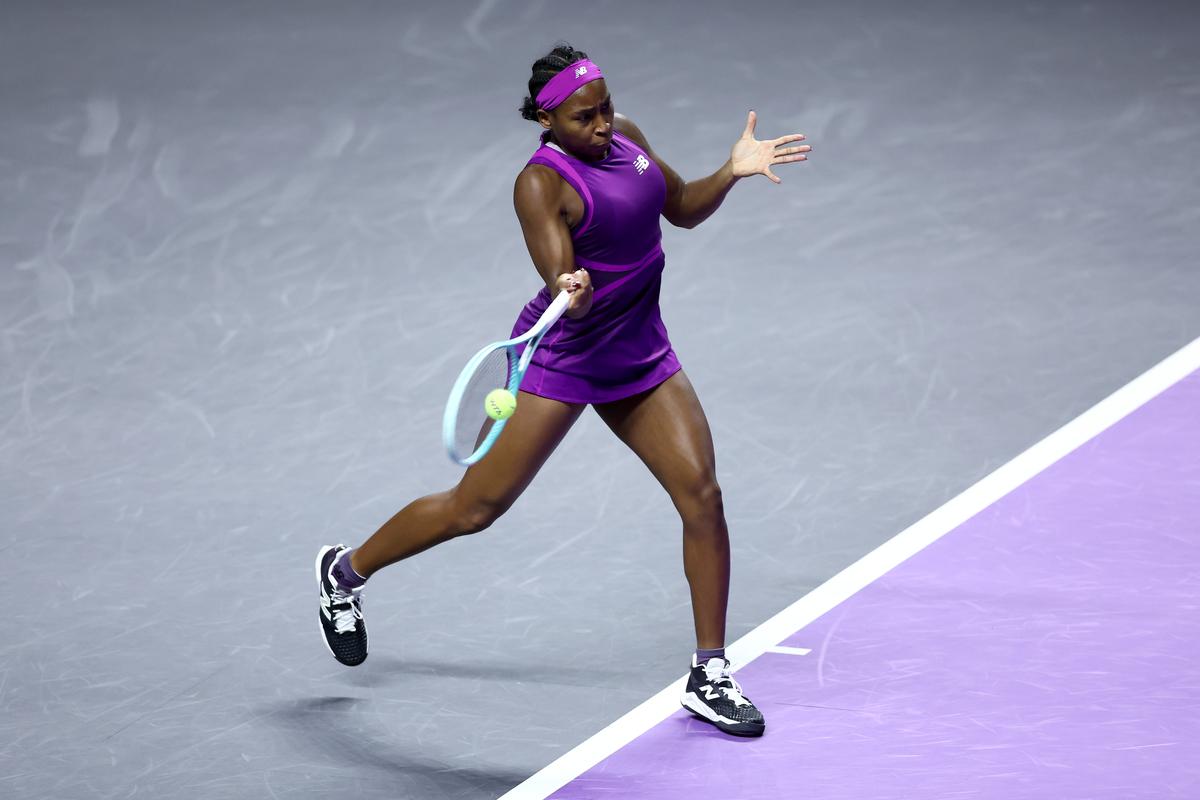
Ending on a high: Coco Gauff, who split with Brad Gilbert and hired Matt Daley after the US Open, salvaged her otherwise disappointing year at the WTA Finals.
| Photo Credit:
Getty Images
Ending on a high: Coco Gauff, who split with Brad Gilbert and hired Matt Daley after the US Open, salvaged her otherwise disappointing year at the WTA Finals.
| Photo Credit:
Getty Images
Her fairytale fortnight predictably ended in a crushing defeat to the Queen of Clay. With ruthless efficiency, heavy favourite Swiatek overpowered Paolini 6-2, 6-1 to extend her perfect record in major finals to 5-0. The gracious runner-up told the crowd, “Playing you here is the toughest challenge in the sport.”
When Paolini described the tournament as “the best days of my life,” she could not have imagined what would happen just five weeks later on the pristine lawns of Wimbledon.
Czechmate by Krejcikova
No one predicted that two long shots would make the Wimbledon final — least of all themselves.
Jasmine Paolini, the Cinderella story of the French Open but dismissed here with 50-1 odds, had never won a main-draw match on Wimbledon grass. “Two Grand Slam finals in a row was crazy to believe, I think, no?” admitted the little Italian, who was overpowered by Swiatek 6-2, 6-1 in the French Open final.
Barbora Krejcikova, dismissed at 100-1 odds despite being the 2021 Roland Garros champion, had an unimpressive 13-11 career record on grass and an abysmal 7-9 match record leading into Wimbledon, due to illness, a back injury, and rust. Yet the low-key Czech reignited her singles career — she had amassed seven doubles and three mixed doubles Slam titles — at the world’s most prestigious tennis tournament.
Known for her savvy tactics and versatility, the resourceful Krejcikova defused powerful Elena Rybakina 3-6, 6-3, 6-4 and exclaimed in surprise, “I’m in the finals. Wow!” After recovering from a mid-match collapse to defeat Paolini 6-2, 2-6, 6-4, the jubilant champion exulted, “Nobody believes that I got to the final. And I think nobody’s going to believe that I won Wimbledon. I still cannot believe it. It’s unbelievable.”
Sabalenka, seeded third at Wimbledon, withdrew when the rotator cuff injury she sustained in Berlin made serving difficult. Swiatek suffered a disappointing 3-6, 6-1, 6-2 loss to No. 35 Yulia Putintseva, while Gauff was eliminated by the steadily improving 19th-seeded American, Emma Navarro, 6-4, 6-3.
Entering the Paris Olympics, Swiatek, the firm favourite, had not lost on the Roland Garros clay since 2021, and Zheng had never beaten Swiatek in six career encounters. Driven by “sheer determination,” the Chinese star achieved an impressive 6-2, 7-5 upset in the semifinals. Zheng then seized the gold medal with an almost anti-climactic 6-2, 6-3 victory over 21st-ranked Donna Vekic of Croatia. “To be honest, I always dreamed of one day joining the likes of Yao, Liu, and Li, and being as successful and influential as they were as athletes,” an ecstatic Zheng, the first Chinese and Asian singles gold medallist, told China Daily. “I’ve been working so hard toward that goal, and [have] finally proved that I have what it takes to become the new leader of Chinese tennis. … I feel so privileged and honoured.”
Maintaining control of her volatile emotions has always been key to Sabalenka controlling her high-velocity shots. That was of paramount importance at the US Open, where she had endured heartbreaking three-set losses over the previous three years to Gauff, Swiatek, and Leylah Fernandez. For the past five months, her boyfriend, Georgios Frangulis, a motorsports driver from Brazil, has helped stabilise Sabalenka. After her dominant victory at the Cincinnati Open, where she defeated both Jessica Pegula and Swiatek, she said, “Thank you to my boyfriend for keeping me happy every day.”
Sabalenka, shaken by the tragic suicide of her ex-boyfriend and former NHL player Konstantin Koltsov, had recently told People magazine: “There was a really tough period where I was really happy to have him by my side, always cheering me up, always making sure that we are doing some fun stuff. I make sure I kind of forget about tennis and focus on the good things and enjoy my life, even when things are going wrong in my career.”
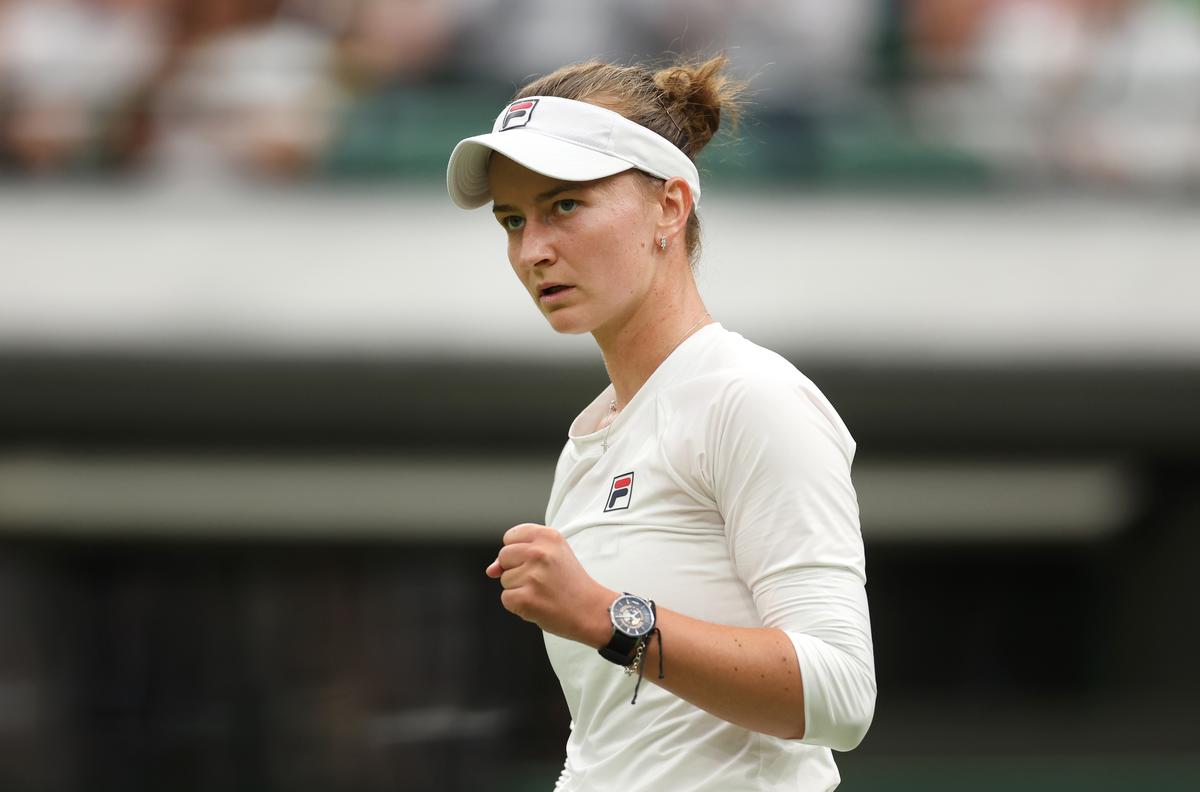
Surprise package: Barbora Krejcikova, the 2021 Roland Garros champion, won Wimbledon against all odds.
| Photo Credit:
Getty Images
Surprise package: Barbora Krejcikova, the 2021 Roland Garros champion, won Wimbledon against all odds.
| Photo Credit:
Getty Images
Everything went right for the Belarusian Basher at the US Open. She overwhelmed Zheng 6-1, 6-2 with a spectacular quarterfinal display of power tennis. Sabalenka exorcised her semifinal demons, beating Navarro 6-3, 7-6(2). In the on-court interview, Shriver asked Sabalenka if she was thinking about last year’s meltdown in the final. Sabalenka answered honestly, “I was thinking a lot.” And defiantly, “Not this time.” Navarro and Pegula, the daughters of billionaires, collected their biggest tournament prize money at the US Open. Navarro repeated her Wimbledon victory over the slumping Gauff, this time winning 6-3, 4-6, 6-3 as Coco committed a shocking 19 double faults. Pegula, who had never advanced past the quarters at a Major before this fortnight, played brilliantly under the guidance of her new coaches, Mark Knowles and Mark Merklin. She upset No. 1 Swiatek 6-2, 6-4 and reached her first Major final in 23 attempts, overcoming Karolina Muchova 1-6, 6-4, 6-2.
Smacking 40 winners and playing the big points better, Sabalenka edged Jessica Pegula 7-5, 7-5 for her first US Open and third Grand Slam crown. During the trophy ceremony, the thoroughly impressed Pegula said, “She’s super powerful. She goes for her shots.”
A year after smashing two rackets in the locker room following her loss to Gauff, Sabalenka hugged and kissed her silver trophy and told ESPN, “I think I’m the happiest person in the world now.”
Gauff, who split with Brad Gilbert and hired Matt Daley after the US Open, salvaged her otherwise disappointing year at the WTA Finals. With a more consistent serve, she outplayed Pegula 6-3, 6-2, Świątek 6-3, 6-4, and Sabalenka 7-6 (4), 6-3 before outlasting Zheng 3-6, 6-4, 7-6 (2) in the thrilling final. Gauff became the first American to win the tournament since Serena in 2014.
Serena, the GOAT, remains the gold standard in women’s tennis. Hall of Famer Shriver paid the new No. 1 the highest compliment when she said, “Sabalenka is almost as intimidating as Serena was.”





